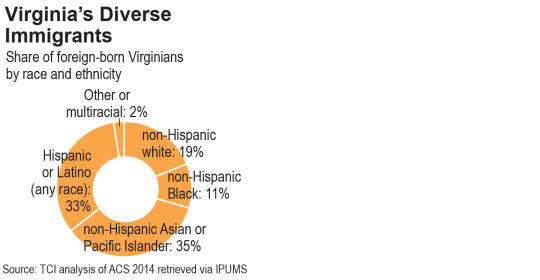July 11, 2016
We’re in This Together
Note: This is the first in a series of blog posts based on The Commonwealth Institute’s new report, We’re In This Together: African-American and Immigrant Communities Share Challenges, Policy Solutions. During July and August, we will be highlighting analysis and policy ideas from each section of the report. For more information about this report and its findings, please contact Laura Goren at laura@thecommonwealthinstitute.org .
Immigrants and African-Americans in Virginia face many of the same challenges, and there are critical state policy solutions that would make a big difference to both.
While most immigrants living in Virginia are people of color, most people of color in Virginia – including most Hispanic and/or Latino Virginians – are not immigrants. Most significant, of course, is Virginia’s African-American community. There are almost 1.5 million Black and/or African-American Virginians who are U.S. born. That’s 18 percent of Virginia’s total population.
Most African-American Virginians are descendents of people who were brought to the United States in chains and faced generations of enslavement, legal segregation, and continued discrimination – a far different history than that of most immigrant Virginians. And yet, there are a number of areas where African-American Virginians and immigrant Virginians face similar challenges today. By identifying those challenges and working together for solutions that benefit everyone, Virginia can be made a better place for all.
Virginia is home to a substantial, and diverse, group of immigrants. More than a million immigrants live in Virginia, four-fifths of whom are people of color. A third of immigrant Virginians identify as Asian, and another third identify as Hispanic and/or Latino. And 1 in 10 Virginia immigrants identify as non-Hispanic and Black or African-American, about a quarter of whom were born in Ethiopia.

Many Virginian families have foreign-born members, and by ensuring the wellbeing of foreign-born adults, we can also help many of Virginia’s children. Many Hispanic and Latino Virginians who are not immigrants live with immigrant family members. There are about 74,000 foreign-born children living in Virginia, and about 350,000 native-born children in Virginia with at least one immigrant parent. That’s about 20 percent of all Virginia children, and the wellbeing and opportunities for success for these children of immigrants – most of whom are children of color – are deeply affected by the opportunities and challenges facing their parents. Virginia is also home to many native-born adults with at least one immigrant parent. These second-generation Americans are also more likely than other Virginians to be people of color.
With so many foreign-born Virginians, it’s important to recognize and address the obstacles Virginia’s immigrants face. Many Virginia immigrants are well educated and bring in good incomes; many others face challenges in the labor market. And beyond measures like income and education, many immigrant communities in Virginia share significant challenges with African-American communities, including residential segregation, schools that too often struggle to meet the needs of all students, lack of health insurance and culturally competent health care, significant caretaking responsibilities without the benefit of paid sick leave and family leave, and harsher punishment in the criminal justice system than U.S. born white Virginians.
It should go without saying that no one should be subject to systematic inequality. Policy changes would help a significant number of Virginians experience the fair treatment they deserve, and be a progressive step in creating a better Virginia for all.
Category:
Immigration
